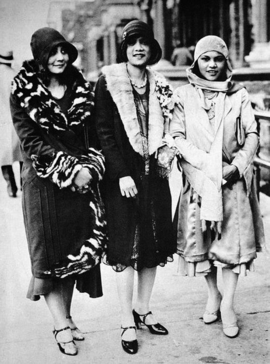
Back نهضة هارلم Arabic Renaixement de Harlem Catalan Harlemská renesance Czech Harlem Renaissance Danish Harlem Renaissance German Harlema renesanco Esperanto Renacimiento de Harlem Spanish Harlemgo Pizkundea Basque رنسانس هارلم Persian Harlemin renessanssi Finnish
| Part of the Roaring Twenties | |
 Three African-American women in Harlem during the Harlem Renaissance in 1925 | |
| Date | 1918–mid-1930s |
|---|---|
| Location | Harlem, New York City, United States and influences from Paris, France |
| Also known as | New Negro Movement |
| Participants | Various artists and social critics |
| Outcome | Mainstream recognition of cultural developments and idea of New Negro |
The Harlem Renaissance was an intellectual and cultural revival of African-American music, dance, art, fashion, literature, theater, politics and scholarship centered in Harlem, Manhattan, New York City, spanning the 1920s and 1930s.[1] At the time, it was known as the "New Negro Movement", named after The New Negro, a 1925 anthology edited by Alain Locke. The movement also included the new African-American cultural expressions across the urban areas in the Northeast and Midwest United States affected by a renewed militancy in the general struggle for civil rights, combined with the Great Migration of African-American workers fleeing the racist conditions of the Jim Crow Deep South,[2] as Harlem was the final destination of the largest number of those who migrated north.
Though it was centered in the Harlem neighborhood, many francophone black writers from African and Caribbean colonies who lived in Paris, France, were also influenced by the movement,[3][4][5][6][7] Many of its ideas lived on much longer. The zenith of this "flowering of Negro literature", as James Weldon Johnson preferred to call the Harlem Renaissance, took place between 1924—when Opportunity: A Journal of Negro Life hosted a party for black writers where many white publishers were in attendance—and 1929, the year of the stock-market crash and the beginning of the Great Depression. The Harlem Renaissance is considered to have been a rebirth of the African-American arts.[8]
- ^ Chambers, Veronica; May-Curry, Michelle (21 March 2024). "The Dinner Party That Started the Harlem Renaissance". Archived from the original on 21 March 2024. Retrieved 21 March 2024.
- ^ "NAACP: A Century in the Fight for Freedom" Archived 1 August 2013 at the Wayback Machine, Library of Congress.
- ^ "Harlem in the Jazz Age". The New York Times. 8 February 1987. Archived from the original on 6 October 2012. Retrieved 26 July 2023.
- ^ Cotter, Holland (24 May 1998). "ART; A 1920s Flowering That Didn't Disappear". The New York Times. Archived from the original on 6 October 2012. Retrieved 26 July 2023.
- ^ "French Connection". Harlem Renaissance. Archived from the original on 10 June 2011. Retrieved 26 July 2023.
- ^ Kirka, Danica (1 January 1995). "Los Angeles Times Interview : Dorothy West : A Voice of Harlem Renaissance Talks of Past--But Values the Now". Los Angeles Times. Archived from the original on 4 October 2013. Retrieved 26 July 2023.
- ^ Hutchinson, George. "Harlem Renaissance". Encyclopædia Britannica. Archived from the original on 19 May 2008. Retrieved 26 July 2023.
- ^ "Project MUSE – Modernism, Mass Culture, and the Harlem Renaissance: The Case of Countee Cullen." Project MUSE – Modernism, Mass Culture, and the Harlem Renaissance: The Case of Countee Cullen. N.p., n.d. Web. 4 April 2015.